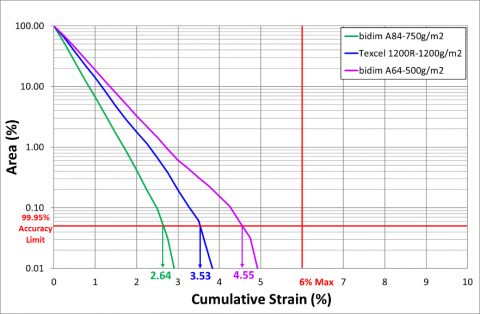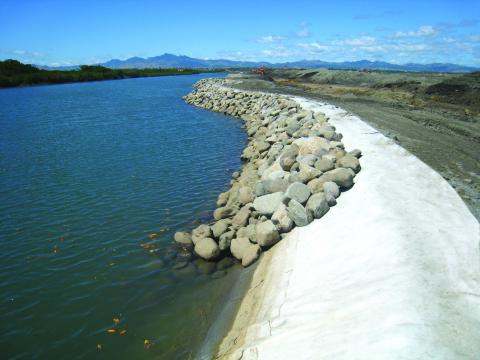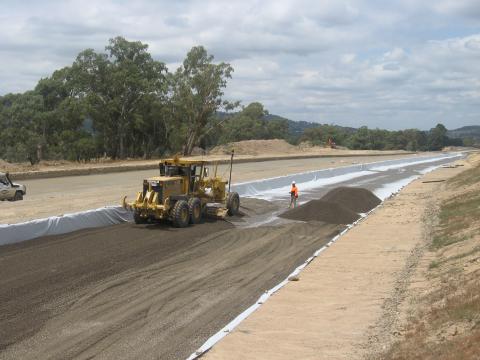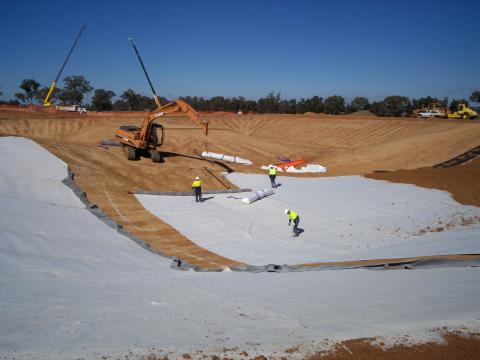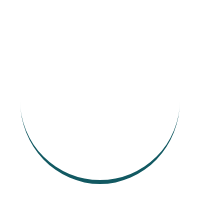

- Home
- News & Insights
- Understanding the Membrane Protection Efficiency of Cushion Geotextiles in Landfill

Not all geotextiles are created equal when it comes to cushioning performance and it is important to consider this when specifying these products.
Quantifying geomembrane strain through specialised analysis using design-specific inputs is essential in understanding the long-term barrier performance of the lining system and often required in regulatory guidelines. In addition, the analysis presents an opportunity to optimise design inputs by determining the performance of different geotextiles. Research undertaken at the Geosynthetic Centre of Excellence has shown the differences in performance of various geotextiles under various drainage aggregates subjected to a range of test loads up to 800kPa, which is conservatively equivalent to around an 80 metre fill depth.
HOW IS STRAIN ANALYSIS PERFORMED?
ASTM D5514/D5514M-14 Large Scale Hydrostatic Puncture Testing of Geosynthetics is used as a general guide to performing this analysis but some of the test setup detail and the method of data analysis has been modified in-line with current technology to improve the precision of the results. The test rig uses a 450mm diameter fixed stone profile constructed from the proposed site-specific aggregate. The stone profile is created by pouring loose stone onto a liquid rubber base. Pneumatic pressure is used to load the geomembrane to the designated test pressure and push it onto a thin metal strain indicator sheet, protection layer and drainage stone. Following the test loading period, the air pressure is released in a controlled manner, the test samples removed and the aluminium strain indicator sheet sent for laser scanning where the cumulative strain in the liner is calculated in 0.25% increments. 3D laser scanning provides a quick and repeatable method of strain analysis across the whole contoured surface of the geomembrane rather than relying on traditional methods that require visual pre-selection of the highest strain regions for detailed manual analysis.
1using an average fill density of 1,000kg/m3.
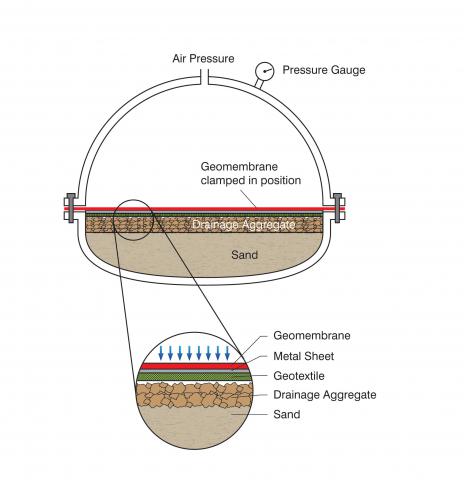
WHAT HAVE WE LEARNT SO FAR?
The research carried out to-date has revealed a number of key points which have assisted both designers and installers in selecting the correct cushion geotextile for their project. These are summarised below:
- The improved test methodology allows a complete quantification of geomembrane strain through the use of current 3D laser scanning technology.
- Strain values are site specific and results are determined by Geomembrane Thickness and Quality, Aggregate Angularity and Loads according to Waste Depth
- bidim continuous filament polyester nonwoven geotextiles have consistently outperformed staple fibre geotextiles in providing strain attenuation of HDPE geomembranes under angular aggregates 20-75 mm
- In standard angular drainage aggregate sizes between 20-75 mm, the geotextile mass required for bidim geotextiles is often lower than staple-fibre geotextiles to provide equal or better performance
- Calendered or heat-set staple fibre geotextiles do not always perform better than mass-equivalent non-calendered geotextiles
- Underlying subgrades including compacted clay and GCLs, provide additional support below the geomembrane, effectively reducing geomembrane strain.
HOW CAN THIS ANALYSIS SAVE ON MATERIAL COSTS?
Because of the way geomembranes used to be assessed, protection geotextiles were (and still are) often specified using Mass as the key parameter. We now know that the protection efficiency can vary greatly between geotextile types, depending on the aggregate type and size. An example to demonstrate is presented below:
A landfill project which has a maximum fill depth of 40m requires 10,000m2 of a cushion geotextile to protect a 2mm smooth HDPE geomembrane baseliner. The aim is to ensure the HDPE strain is kept below 6%, and the specification states that the Mass of the protection geotextile must be >1,200g/m2.
Rock Type
There is a 20mm single graded angular aggregate available that will incur higher transport and crushing costs than a cheaper 20-50mm angular aggregate onsite. The larger aggregate is preferred economically for the leachate drainage layer but the designer is unsure if the larger stone will meet the geomembrane strain criteria.
Geotextile Type
There are three geotextiles available; one is a staple fibre needle-punched nonwoven (Texcel 1200R) which meets the Mass criteria and is the most expensive. The second is a continuous filament needle-punched nonwoven (bidim A84), which doesn’t meet the Mass criteria but may meet the strain criteria and presents as a more economic option. The third option is a bidim A74 which is a lighter and cheaper again.
Related Products
Related Sectors
KEEP UP TO DATE WITH THE LATEST FROM
GEOFABRICS BY SUBSCRIBING TO OUR NEWSLETTER
GEOFABRICS
AUSTRALASIA
PTY LTD

